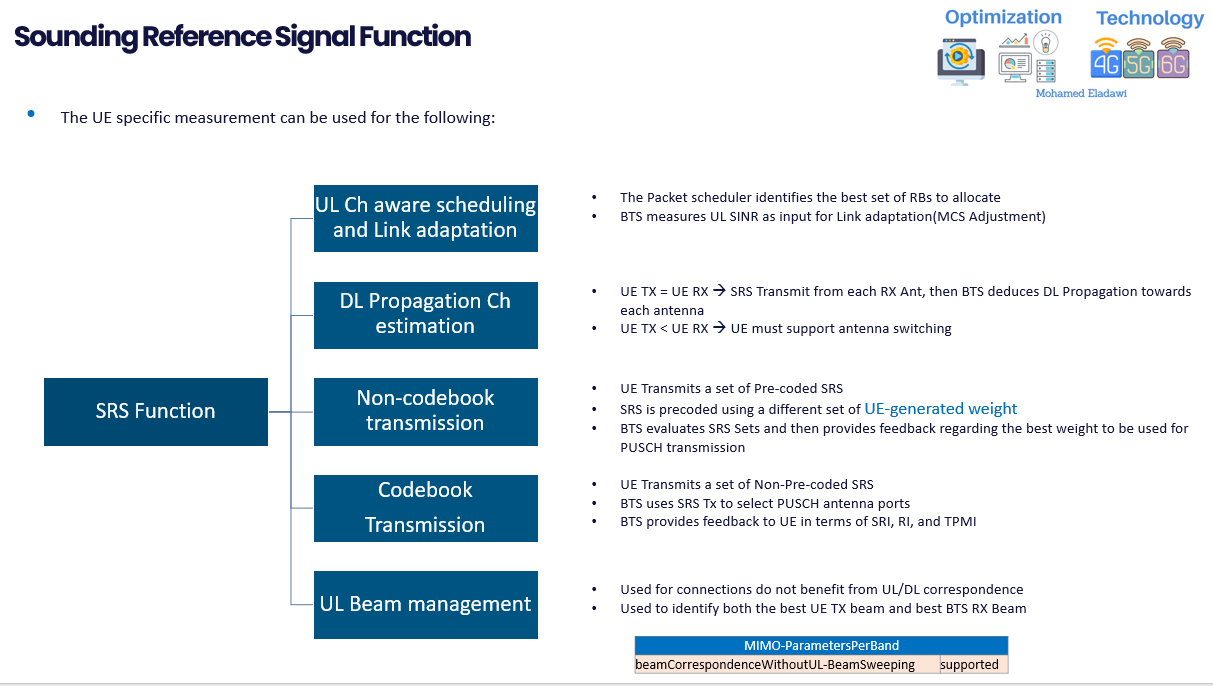A Complete Guide to 5G NR SRS: Sounding Reference Signals in Uplink
telcomatraining.com – As 5G New Radio (NR) continues to revolutionize mobile communications, various advanced features play a crucial role in achieving high performance, low latency, and efficient resource usage. One such essential feature is the Sounding Reference Signal (SRS) in the uplink direction. In this guide, we explore what 5G NR SRS is, how it functions, and why it matters for next-generation wireless communication.
What is 5G NR SRS?
Sounding Reference Signals (SRS) are special uplink reference signals transmitted by the User Equipment (UE) to enable the gNB (next-generation Node B or 5G base station) to acquire accurate channel state information (CSI). Unlike other reference signals such as DMRS (Demodulation Reference Signal), which support data demodulation, SRS is primarily used for uplink channel sounding and scheduling decisions.
In simpler terms, SRS helps the base station understand how the radio channel behaves in different frequency bands, enabling better uplink resource allocation, beamforming, and link adaptation.
Key Functions of SRS
- Uplink Channel Estimation:
The main purpose of SRS is to provide accurate information about the uplink channel quality over a wide frequency range. This enables the base station to optimize frequency-domain scheduling. - Beam Management:
SRS is used for uplink beamforming decisions. By transmitting SRS using different antenna configurations, the gNB can evaluate which beam offers the best performance. - Mobility Support and Handover:
SRS can be used by neighboring cells to measure uplink signal quality from a UE, assisting in handover decisions and mobility robustness. - Massive MIMO Optimization:
In networks deploying massive MIMO, SRS assists in uplink channel estimation required for effective multi-user MIMO operation.
How SRS Works in 5G NR
SRS is transmitted periodically or on-demand by the UE based on configuration from the gNB. The configuration includes parameters like:
- SRS periodicity: Defines how often the UE should send SRS.
- SRS sequence: Specifies the frequency position and bandwidth of the signal.
- Antenna port mapping: Determines which antenna is used for transmission.
SRS transmission can be configured in several modes:
- Configured SRS Transmission: Periodic or semi-persistent transmission based on predefined intervals.
- Aperiodic SRS Transmission: On-demand SRS triggered by a DCI (Downlink Control Information) message.
This flexibility allows network operators to tailor SRS usage to specific scenarios, such as low-latency applications, carrier aggregation, or dense urban deployments.
Advantages of Using SRS in 5G
- Improved Uplink Performance: SRS ensures better channel knowledge, enabling the gNB to allocate resources more effectively.
- Enhanced Beamforming: With accurate channel estimates, beamforming techniques are more effective, resulting in improved signal quality and reduced interference.
- Efficient Use of Spectrum: By sounding large frequency ranges, the network can exploit frequency diversity, boosting overall capacity.
- Reduced Overhead: Compared to continuous channel estimation, SRS provides a targeted and efficient solution for uplink assessment.
Challenges and Considerations
While SRS is powerful, it introduces some complexity in terms of configuration and resource allocation. Some considerations include:
- Overhead vs. Benefit Trade-Off: Frequent SRS transmission improves accuracy but increases uplink overhead.
- UE Capability: Not all devices support advanced SRS features, especially in low-cost or IoT scenarios.
- Coordination in Dense Networks: In ultra-dense networks, managing SRS transmission across many UEs becomes challenging and requires careful planning.
Conclusion
5G NR SRS is a vital mechanism for optimizing uplink performance, supporting intelligent scheduling, and enabling advanced features such as beamforming and massive MIMO. As 5G networks scale and become more complex, the role of SRS becomes increasingly important in achieving the desired performance goals. Understanding and properly configuring SRS is key to unlocking the full potential of 5G NR in real-world deployments.







